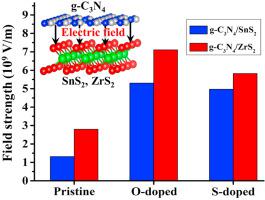Journal of Materiomics ( IF 8.4 ) Pub Date : 2021-03-02 , DOI: 10.1016/j.jmat.2021.02.015 Bicheng Zhu , Haiyan Tan , Jiajie Fan , Bei Cheng , Jiaguo Yu , Wingkei Ho

|
Single photocatalysts usually exhibit unsatisfactory performance due to the serious recombination of photogenerated electron‒hole pairs. Combining two photocatalysts to construct S-scheme heterojunction could solve this problem. In S-scheme mechanism, the interfacial built-in electric field (IEF) provides a vital driving force for efficient charge separation. Modifying the IEF is a feasible strategy to further improve the photocatalytic activity. Herein, a novel idea of tuning the strength of IEF in 2D/2D graphitic carbon nitride (g-C3N4)/MS2 (M = Sn, Zr) S-scheme heterojunctions by nonmetal doping was developed by employing density functional theory calculation. Three nonmetal elements (O, P, and S) were severally introduced into g-C3N4/MS2 composites. Charge density difference suggested that O and S doping led to increased interfacial electron transfer, while P doping had minimal influence. As expected, the calculated field strength of O- and S-doped g-C3N4/MS2 composites was significantly larger than that of pristine and P-doped g-C3N4/MS2 composites. Therefore, O and S doping endowed g-C3N4/MS2 S-scheme heterojunctions with enhanced IEF and more thorough charge transfer. Correspondingly, the experimentally synthesized O-C3N4/SnS2 composite exhibited better photocatalytic H2-production activity than g-C3N4/SnS2 composite. This work proposed an original idea of employing proper nonmetal doping to magnify the advantage of S-scheme heterojunction in accelerating charge separation.
中文翻译:

通过非金属掺杂调节 2D/2D gC 3 N 4 /SnS 2和 gC 3 N 4 /ZrS 2 S 型异质结中的内置电场强度
由于光生电子-空穴对的严重复合,单一光催化剂通常表现出令人不满意的性能。结合两种光催化剂构建 S 型异质结可以解决这个问题。在 S 型机制中,界面内建电场 (IEF) 为有效的电荷分离提供了重要的驱动力。修改IEF是进一步提高光催化活性的可行策略。在此,通过采用密度泛函理论计算,开发了一种通过非金属掺杂调节 2D/2D 石墨氮化碳 (gC 3 N 4 )/MS 2 (M = Sn, Zr) S 型异质结中 IEF 强度的新想法。三种非金属元素(O、P 和 S)分别引入 gC 3N 4 /MS 2复合物。电荷密度差异表明 O 和 S 掺杂导致界面电子转移增加,而 P 掺杂影响最小。正如预期的那样,O 和 S 掺杂的 gC 3 N 4 /MS 2复合材料的计算场强明显大于原始和 P 掺杂的 gC 3 N 4 /MS 2复合材料的场强。因此,O和S掺杂赋予gC 3 N 4 /MS 2 S型异质结增强的IEF和更彻底的电荷转移。相应地,实验合成的 OC 3 N 4 /SnS2复合具有更好的光催化ħ 2 -production活性比GC 3 Ñ 4 / SnS的2复合物。这项工作提出了采用适当的非金属掺杂来放大 S 型异质结在加速电荷分离方面的优势的原创想法。











































 京公网安备 11010802027423号
京公网安备 11010802027423号